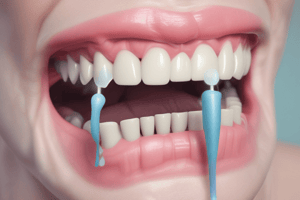Podcast
Questions and Answers
Match the following stimuli with their effect on dentinal fluid flow:
Match the following stimuli with their effect on dentinal fluid flow:
Cold = Fluid flow away from the pulp Heat = Fluid flow toward the pulp Sugar solution = Fluid flow toward the pulp Salt solution = Fluid flow away from the pulp
Match the following conditions with their association with tooth wear:
Match the following conditions with their association with tooth wear:
Bulimia = Erosion Gastroesophageal reflux disease (GERD) = Attrition Gingival recession = Abrasion Periodontal procedures = Erosion
Match the following clinical methods with their purpose in diagnosing dentin hypersensitivity:
Match the following clinical methods with their purpose in diagnosing dentin hypersensitivity:
Jet of air = Diagnosing dentin hypersensitivity Probe or explorer = Measuring dentin tubule diameter Radiographic examination = Identifying etiological factors Vital tooth bleaching = Treating dentin hypersensitivity
Match the following characteristics with their relevance to dentin hypersensitivity pain:
Match the following characteristics with their relevance to dentin hypersensitivity pain:
Match the following solutions with their effect on dentinal fluid flow:
Match the following solutions with their effect on dentinal fluid flow:
Match the following factors with their role in diagnosing dentin hypersensitivity:
Match the following factors with their role in diagnosing dentin hypersensitivity:
Match the following theories with their explanation related to dentin hypersensitivity:
Match the following theories with their explanation related to dentin hypersensitivity:
Match the following symptoms with their characteristics related to dentin hypersensitivity:
Match the following symptoms with their characteristics related to dentin hypersensitivity:
Match the following age groups with their prevalence of dentin hypersensitivity:
Match the following age groups with their prevalence of dentin hypersensitivity:
Match the following teeth with their incidence of dentin hypersensitivity:
Match the following teeth with their incidence of dentin hypersensitivity:
Match the following stimuli with their effect on dentin hypersensitivity:
Match the following stimuli with their effect on dentin hypersensitivity:
Match the following factors with their importance in dentin hypersensitivity:
Match the following factors with their importance in dentin hypersensitivity:
Match the following reasons with the decrease in dentin permeability:
Match the following reasons with the decrease in dentin permeability:
Match the following prevention methods with the correct description:
Match the following prevention methods with the correct description:
Match the following treatment options with the correct description:
Match the following treatment options with the correct description:
Match the following with the management of dentin hypersensitivity:
Match the following with the management of dentin hypersensitivity:
Match the following with the cause of dentin hypersensitivity:
Match the following with the cause of dentin hypersensitivity:
Match the following with the prevention method for dentin hypersensitivity:
Match the following with the prevention method for dentin hypersensitivity:
Match the following dentifrices with their active ingredients:
Match the following dentifrices with their active ingredients:
Match the following in-office treatment procedures with their mechanisms of action:
Match the following in-office treatment procedures with their mechanisms of action:
Match the following treatment options with their effects on dentin hypersensitivity:
Match the following treatment options with their effects on dentin hypersensitivity:
Match the following active ingredients with their treatment methods:
Match the following active ingredients with their treatment methods:
Match the following treatment options with their benefits:
Match the following treatment options with their benefits:
Match the following treatment options with their potential side effects:
Match the following treatment options with their potential side effects:
Match the following treatments with their mechanisms of action in treating dentin hypersensitivity:
Match the following treatments with their mechanisms of action in treating dentin hypersensitivity:
Match the following treatments with their primary benefits in treating dentin hypersensitivity:
Match the following treatments with their primary benefits in treating dentin hypersensitivity:
Match the following components with their role in arginine-based product:
Match the following components with their role in arginine-based product:
Match the following treatments with their application methods in treating dentin hypersensitivity:
Match the following treatments with their application methods in treating dentin hypersensitivity:
Match the following treatments with their effects on dentinal tubules in treating dentin hypersensitivity:
Match the following treatments with their effects on dentinal tubules in treating dentin hypersensitivity:
Match the following treatments with their availability in treating dentin hypersensitivity:
Match the following treatments with their availability in treating dentin hypersensitivity:




